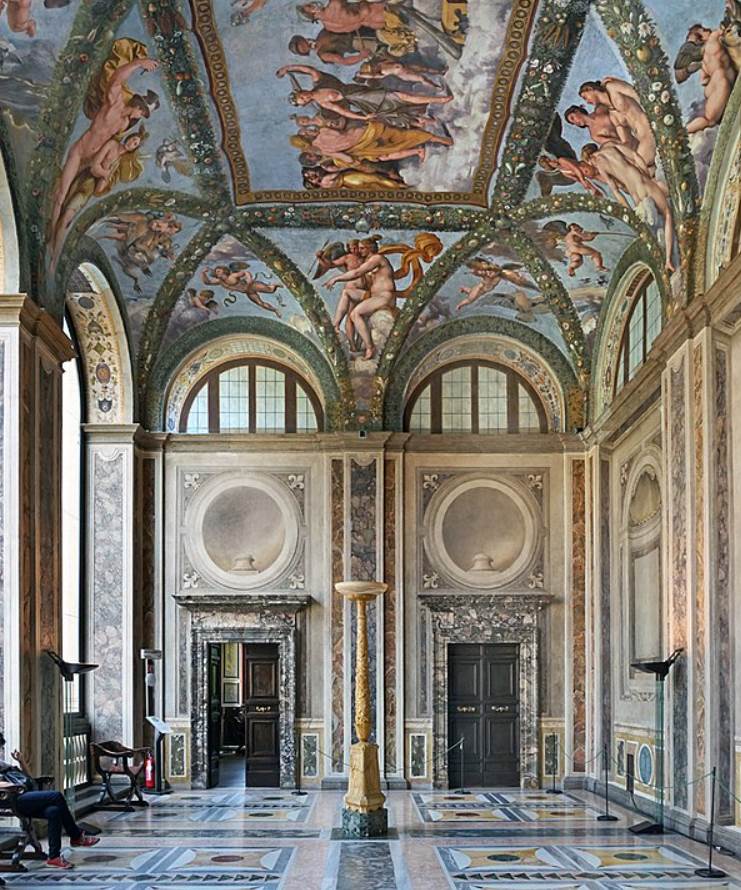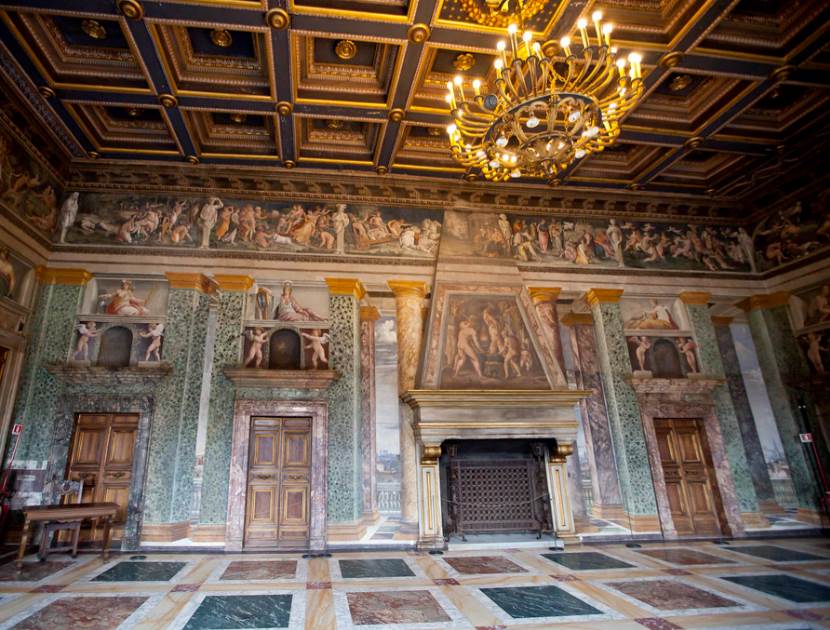This suburban mansion from the early 16th century might not be the most famous building in Rome, but it still houses some of the greatest frescoes in the city.
This villa is an amazing Renaissance building that was commissioned by one of the richest people of the Renaissance. He didn’t hold back on spending money to decorate it, that’s for sure.
Let’s take a closer look at some of the most interesting facts about the Villa Farnesina in Rome, one of the city’s most remarkable treasures.
1. It’s located in the Trastevere District in central Rome
The Villa Farnesina is a stunning Renaissance mansion that is located in the Trastevere District of Rome. The word “Trastevere” was derived from the Latin “Trans Tiberim.”
This means that it’s located on the opposite bank of the Tiber River than the historical heart of the ancient city of Rome.
This district is bounded by the Tiber and the Janiculum, the second-tallest hill in modern-day Rome. This is, however, not one of the Seven Hills of Rome as this was merely a rural area in ancient times.
The villa is separated from the Tiber by a road called the Lungotevere Farnsesina. The Palazzo Corsini, an amazing Baroque building that houses a collection of 16th and 17th-century art, borders it to the west.

2. It was commissioned by the treasurer of Pope Julius II
The building was commissioned by Agostino Chigi, a rich banker from Siena who had lived in Rome since 1487. He occupied several important positions which allowed him to amass great wealth.
When he became the secretary and treasurer of the Papal States for helping Giuliano della Rovere become Pope Julius II (1443-1513), his wealth grew to epic proportions.
The building was commissioned to serve as the suburban villa of the rich banker and was constructed between 1506 and 1510.

3. It was a revolutionary Renaissance building due to its remarkable design
This remarkable structure had a design that was in sheer contrast to the Renaissance palaces that had been erected in Rome at the time.
It was designed by Baldassare Peruzzi (1581-1536), a relatively young architect at the time who was a pupil of Donato Bramante (1444-1514), the original architect of St. Peter’s Basilica.
He was also involved in the construction of St. Peter’s Basilica, even after Bramante passed away. He likely worked together with Antonio da Sangallo the Younger (1484-1546) on both projects.
The most remarkable difference between the Renaissance palaces and this suburban villa was its U-shaped design.
The loggia on the northern part of the structure was left open and served as the main entrance of the building.

4. The Villa Farnesina is decorated with a large number of frescoes
Agostino Chigi didn’t stop with merely constructing the villa, he also spent vast amounts of money on decorating it.
Raphael, Sebastiano del Piombo, Giulio Romano, and Il Sodoma are the artist that earned a commission to paint frescoes inside the building shortly after it was completed.
The common theme of these frescoes was derived from scenes from a renaissance poem called “Stanze per la Giostra, written by the Italian poet Poliziano (1454-1494).
This poem was in turn derived from other works such as Ovid’s Metamorphoses, which means many figures are mythological creatures.

5. One of the most stunning frescoes is an amazing example of trompe-l’œil
Baldassare Peruzzi wasn’t solely the architect of the building, he also designed it. He painted one of the most amazing frescoes inside the building on the first-floor level.
The main room features trompe-l’œil frescoes that depict an open-air loggia and distant landscape.
The illusionary effect provides an extra dimension to this magnificent room. When you stand in a certain location, the landscape appears to be incredibly accurate.
Other frescoes on this level were completed by Il Sodoma and depict scenes from the life of Alexander the Great. This includes Alexander’s wedding to Roxana and Alexander receiving the family of Darius.

6. Raphael completed two amazing frescoes at the ground level of the villa
Although most frescoes at the Villa Farnesina are amazing works of art, nothing compares to the ones completed by one of the greatest Renaissance masters in history.
The paintings by Raphael are located in the loggia and on the ground floor. The one in the loggia is titled “The Wedding Banquet of Cupid and Psyche” and was completed in 1517.

The fresco located in the main room on the ground floor is titled “The Triumph of Galatea” and depicts the water nymph Galatea during his apotheosis.
There were rumors that the beautiful woman in this fresco was modeled on a courtesan named Imperia Cognati, the lover of Agostino Chigi, but Raphael refuted this notion.

7. Michelangelo proposed an additional structure for the villa that was never completed
One of the most interesting facts about the Villa Farnesina is that it was originally referred to as the Villa Chigi in reference to the man who commissioned it.
The villa was acquired by the powerful Farnese family in 1577 who renamed it that year. They also owned the Palazzo Farnese which is situated don’t the other side of the Tiber in the heart of the city.
If it was up to Michelangelo, both buildings would have been connected by a walking bridge. He proposed to build this structure in the 16th century.
The Renaissance sculptor was the architect of the palazzo at the time and although preparatory plans were made, the bridge was never constructed. Some arches at the back of the palace are the only remnants of Michelangelo’s ambiguous plan.

8. The villa is owned by the Italian state and is a museum open to visitors
The villa changed hands several times more. It became the property of the House of Bourbon who ruled in Naples and of the Spanish Ambassador in Rome in 1861.
Today, the villa is owned by the Italian state and is operated as a museum. Guided tours are available as well.
This means that you can admire the remarkable Renaissance architecture and copious amounts of amazing frescoes at the Villa Farnesina during your stay in Rome.




